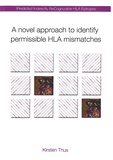Predicted Indirectly ReCognizable HLA Epitopes
A novel approach to identify permissible HLA mismatches
Summary
Allogeneic hematopoietic-cell transplantation (allo-HCT) with an HLA-mismatched donor leads to an increased risk of alloreactivity and reduced survival compared to HCT with HLA-matched donors. However, for many patients, a completely HLA-matched donor is hard to find due to the enormous polymorphic repertoire of HLA, and therefore HLA-mismatched donors are frequently selected. In these situations, criteria to select the “best” mismatched donor were poorly defined. The aim of this thesis was to develop a predictive method for permissible HLA mismatches. The constructed Predicted Indirectly ReCognizable HLA Epitope (PIRCHE) model is a computational method that predicts the probability of indirect T-cell recognition for all potential HLA-mismatch combinations. PIRCHE predict the probability of indirect T-cell recognition by determining which unique peptides derived from the mismatched HLA can be presented on shared HLA. PIRCHE can presented on HLA class I and II (PIRCHE-I and –II, respectively). Theoretically, PIRCHE-I predict the probability of CD8+ T cell responses and PIRCHE-II of CD4+ T cell responses. The effect of PIRCHE on clinical outcome after allo-HCT was investigated in different transplant settings: transplantation with cells derived from adult unrelated donors (URD) or from cord blood (CB). First, a large cohort of patients transplanted with a single HLA-mismatched (9/10) URD was studied. Patients in the lowest tertiles of PIRCHE-I and –II had comparable clinical outcome as patients transplanted with an HLA-matched URD. Patients with higher PIRCHE-I or –II numbers had significantly impaired overall survival (OS) compared to 10/10-matched transplantations, caused by an increased probability of acute graft-versus-host disease (GVHD) and non-relapse mortality (NRM). The reduced toxicity rate of low PIRCHE mismatches was not counterbalanced by an increased probability of relapse. In addition, it was studied whether PIRCHE-I and –II were also correlated to alloreactivity in case of 10/10-matched HCT with a mismatch for HLA-DPB1. Indeed, in patients with an HLA-DPB1 mismatch, the presence of PIRCHE-I and –II was indicative of acute GVHD development as well. These data therefore indicate that HLA-mismatched URD selection may be improved by selecting HLA mismatches resulting in low PIRCHE-I and –II. CB appears to be more tolerant for HLA mismatches, resulting in reduced GVHD risks compared to URD-HCT, and CB may have an improved graft-versus-tumor (GVT) effect. The effect of PIRCHE on clinical outcome after CB-HCT was studied in both single and double unit CB-HCT. In both these transplant settings, PIRCHE-I had a specific anti-leukemic effect: patients receiving CB-HCT had a highly reduced relapse risk when the numbers of PIRCHE-I were high. In double unit CB-HCT, high PIRCHE-II were potentially associated with an increased chronic GVHD risk. These studies indicate that for CB-HCT in case of a malignancy, selecting donors based on high numbers of PIRCHE-I may improve the anti-tumor potential. Finally, the presence of donor cells in the peripheral blood of patients after allo-HCT was required for the PIRCHE effect and patients with PIRCHE had higher numbers of T cells in their cutaneous acute GVHD infiltrates. In conclusion, PIRCHE were clearly correlated to clinical alloreactivity after different types of HLA-mismatched HCT.
